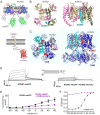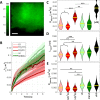Fluorescence Fluctuation Spectroscopy enables quantification of potassium channel subunit dynamics and stoichiometry
- PMID: 34021177
- PMCID: PMC8140153
- DOI: 10.1038/s41598-021-90002-2
Fluorescence Fluctuation Spectroscopy enables quantification of potassium channel subunit dynamics and stoichiometry
Abstract
Voltage-gated potassium (Kv) channels are a family of membrane proteins that facilitate K+ ion diffusion across the plasma membrane, regulating both resting and action potentials. Kv channels comprise four pore-forming α subunits, each with a voltage sensing domain, and they are regulated by interaction with β subunits such as those belonging to the KCNE family. Here we conducted a comprehensive biophysical characterization of stoichiometry and protein diffusion across the plasma membrane of the epithelial KCNQ1-KCNE2 complex, combining total internal reflection fluorescence (TIRF) microscopy and a series of complementary Fluorescence Fluctuation Spectroscopy (FFS) techniques. Using this approach, we found that KCNQ1-KCNE2 has a predominant 4:4 stoichiometry, while non-bound KCNE2 subunits are mostly present as dimers in the plasma membrane. At the same time, we identified unique spatio-temporal diffusion modalities and nano-environment organization for each channel subunit. These findings improve our understanding of KCNQ1-KCNE2 channel function and suggest strategies for elucidating the subunit stoichiometry and forces directing localization and diffusion of ion channel complexes in general.
Conflict of interest statement
The authors declare no competing interests.
Figures






Similar articles
-
KCNE1 binds to the KCNQ1 pore to regulate potassium channel activity.Neuron. 2004 Jun 24;42(6):927-37. doi: 10.1016/j.neuron.2004.06.001. Neuron. 2004. PMID: 15207237
-
Dynamic subunit stoichiometry confers a progressive continuum of pharmacological sensitivity by KCNQ potassium channels.Proc Natl Acad Sci U S A. 2013 May 21;110(21):8732-7. doi: 10.1073/pnas.1300684110. Epub 2013 May 6. Proc Natl Acad Sci U S A. 2013. PMID: 23650380 Free PMC article.
-
KCNE2 confers background current characteristics to the cardiac KCNQ1 potassium channel.EMBO J. 2000 Dec 1;19(23):6326-30. doi: 10.1093/emboj/19.23.6326. EMBO J. 2000. PMID: 11101505 Free PMC article.
-
The membrane protein KCNQ1 potassium ion channel: Functional diversity and current structural insights.Biochim Biophys Acta Biomembr. 2020 May 1;1862(5):183148. doi: 10.1016/j.bbamem.2019.183148. Epub 2019 Dec 9. Biochim Biophys Acta Biomembr. 2020. PMID: 31825788 Free PMC article. Review.
-
KCNE regulation of KvLQT1 channels: structure-function correlates.Trends Cardiovasc Med. 2002 May;12(4):182-7. doi: 10.1016/s1050-1738(02)00158-5. Trends Cardiovasc Med. 2002. PMID: 12069759 Review.
Cited by
-
KCNQ and KCNE Isoform-Dependent Pharmacology Rationalizes Native American Dual Use of Specific Plants as Both Analgesics and Gastrointestinal Therapeutics.Front Physiol. 2021 Nov 11;12:777057. doi: 10.3389/fphys.2021.777057. eCollection 2021. Front Physiol. 2021. PMID: 34858215 Free PMC article.
-
Kv Channel Ancillary Subunits: Where Do We Go from Here?Physiology (Bethesda). 2022 Sep 1;37(5):0. doi: 10.1152/physiol.00005.2022. Physiology (Bethesda). 2022. PMID: 35797055 Free PMC article. Review.
References
Publication types
MeSH terms
Substances
Grants and funding
LinkOut - more resources
Full Text Sources
Other Literature Sources
Research Materials

